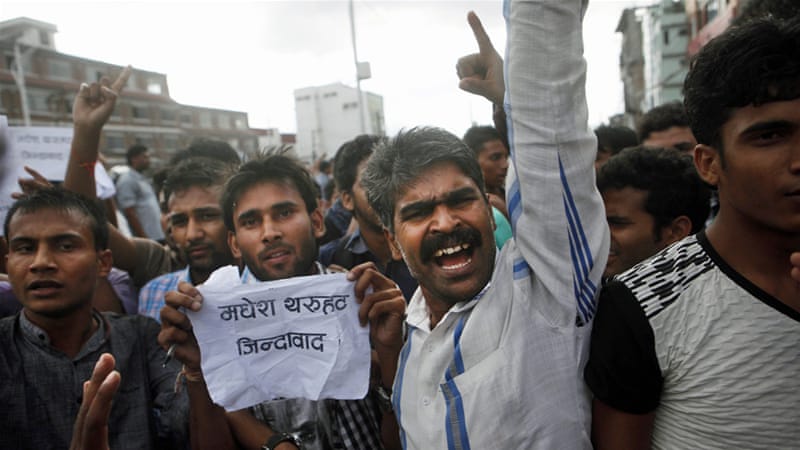A new constitution has finally been
ratified after years of disputes and delays in Nepal. It will be
divided into seven federal provinces, a move aimed at devolving power from
the capital Kathmandu. But some ethnic groups say the division leaves them
under-represented in parliament. They include the Madhesi and Tharu ethnic
minorities, who mainly live in the southern plains along the border
with India. Its the first constitution drafted by representatives of the
people. In the past, constitutions were either written by the monarch
or by a committee selected by the king or queen.
Letz analyse it !!!
Some Features of the Nepali
Constitution !!
In terms of its letter and rhetoric, the new
constitution embraces principles such as federalism, secularism, inclusiveness
and republicanism. The charter also addresses key concerns of almost all
political actors. From that point of view, it is a more modern constitution,
which, in principle, aims to promote the participation of all Nepalis in
governing the country.
 |
- It has
the provision of a bicameral legislation.
- The lower house or the house of representatives will
have 375 members and the upper house has 60 members.
- The constitution has 37 divisions,
304 articles and 7 annexes.
- The seven provinces will be finalised by a high-level
commission within a year.
- It has incorporated a radical provision Article 18 that
states: "All citizens shall be equal before the law. No person shall
be denied the equal protection and benefit of the laws. There shall be no discrimination in the application of general
laws on grounds of religion, race, origin, caste, tribe, gender, sexual orientation,
physical conditions, health conditions, physical impairment, matrimonial
status, pregnancy, economic condition, language or geographical region or
ideology and such other matters."
Thus becoming first
constitution in South Asia, speaking about rights of sexual minorities.
- Article 42, titled Right to Social Justice,
specifically includes "gender and sexual minorities."
- Article 12 addresses citizenship "based
on lineage and gender identity." "Each citizen shall be provided
with (a) Nepali citizenship certificate based on lineage of the mother or
father along with gender identity,"
What are the flaws?
- There
are specifics in the charter which are either regressive or have not been
fully thrashed out. For example, it privileges men when it
comes to conferring citizenship and further restricts the rights of women,
including those granted by previous constitutions.
- It also lacks specifics in terms of local elections and federal demarcation.
- These are very critical issues that will resurface once the constitution
is promulgated. And we can only hope that critics will resort to peaceful
means of dissent in both instances such as using the courts for remedies.
Why this second- class
treatment to Nepali women?

- The main argument the three main political
parties use is that they don't want men from neighboring countries such as
India and China marrying Nepali women and causing unwanted population
growth which they view as some sort of threat to national security.
Smaller
opposition parties rejected the new constitution in a joint statement, and
announced a nationwide general strike on Sunday. Why do they object to the
document?
- 25
members of the Constituent Assembly (CA) voted against the charter, and 66
abstained out of a total of 598 CA members. This means that 507 members
supported the adoption of the bill.
- The
25 members who voted against the charter represent the Hindu extremist
right wing that wants Nepal to become a Hindu nation and not a
secular one.
- Those who abstained, on the other hand, did not want to
participate in a constitutional process which failed to give a voice to
the Tharu and the Madhesi ethnic communities who predominantly reside in
the country's southern plains bordering India. These small parties demand either a separate
province for these groups or recognition in the form of certain privileges
awarded to them in the federal provinces or in the south.
- Given
the amount of people this 66 CA members represent, their abstention means
that a very significant block of Nepalis chose not to take part in the
vote.
Why are the Madhesis and
Tharus protesting ?
- Minority Madhesi and Tharus groups, living in plains – the Terai
region -- just across the borders of UP and Bihar are protesting, over making country a seven-province
federal structure.

What are India's concerns ?
- Urging Kathmandu to address differences and concerns of
a section of its population through dialogue free from violence and
intimidation and in an institutionalised manner, the MEA statement said
only that process would enable a broad-based ownership and acceptance of
the constitution.
- India believes that the Nepali political leaders didn't
exercise the flexibility to bring on board all regions and sections of
society.
- Therefore, the assessment in the security establishment
in Delhi is that the process could sow the seeds for future instability,
right across the open border.
- Last year, when Prime Minister Narendra Modi addressed
the Constituent Assembly in Kathmandu, he said the constitution should be
such that people from Himal, Pahad and Terai can own it. He reiterated this message during a second
visit, and categorically gave a call for a consensus-based constitution.
- Another factor upsetting New Delhi is the
disinformation campaign under way in Nepal that India had instigated the
Madhes movement.
************************************************************************
Moral
of the Story :-
I think Nepal will remain
at a crossroads. I don't see how the new charter will bring stability in the
near term as this will depend on getting the Tharu and the Madhesi politicians
and their constituencies on board - probably with promises that the very first
amendment of the constitution will address their demands.

